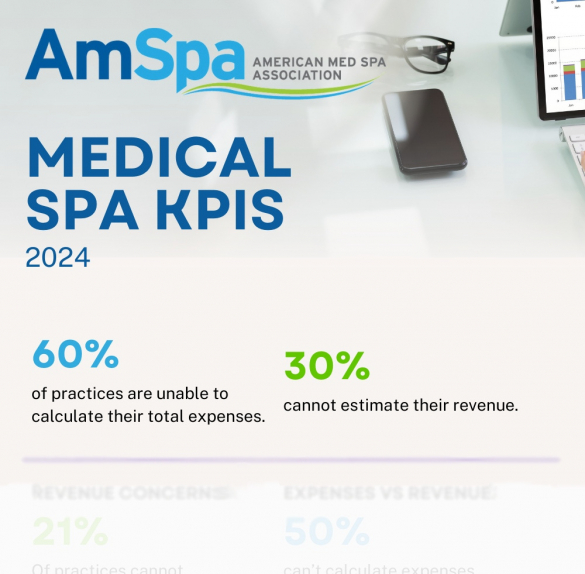2. Medical spa business plan
A detailed business plan is essential for a successful medical spa practice. In any small business it is possible to be busy, to be generating a lot of cash and to still be losing money. It's important to remember that sales don't always equal profitability.
To achieve a positive bottom line, it's crucial to closely monitor operating expenses and truly understand the significance of the numbers and how to keep them in proper alignment. This involves breaking down the numbers into manageable, actionable steps that can be taken on a daily basis.
A properly laid out business plan not only lets you walk forward with confidence in your day-to-day operations, but it also sets you up for success if you need to raise capital in the form of investments or loans.
It all begins with having a clear vision for your practice. By envisioning where you want to take your business, you can create a roadmap for financial success. This vision serves as a guiding light, helping you make informed decisions and prioritize your financial goals.
To get started on making your medical spa business plan, get to know the following concepts.
Financial projections
Including pro forma financial statements is a crucial aspect of every business plan. These statements not only provide a snapshot of your current financial position but also serve as a powerful tool to project and anticipate the future profitability of your business.
When crafting your projections, it is paramount to base them on realistic research and reasonable assumptions. Honesty and transparency are key, as any exaggeration of revenues or underestimation of expenses can lead to misguided expectations and potential financial instability down the line.
By presenting a comprehensive and accurate financial forecast, you can instill confidence in lenders and investors, demonstrating your commitment to responsible financial management.
Including well-crafted pro forma financial statements is not just a formality, but a critical step towards establishing the credibility and viability of your med spa. These may include:
- Pro Forma Income Statement
-
Pro Forma Cash Flow Statement
-
Pro Forma Balance Sheet
-
Yearly Projections (Income Statement, Cash Flow Statement, & Balance Sheet)
Income statements
Income statements are a valuable tool for assessing the profitability of your business. By carefully reviewing your gross sales in comparison to the expenses you incur, you can gain insights into the overall health and performance of your operations. This allows you to accurately calculate both your gross service and retail sales, while also accounting for the various costs associated with running your business.
While you do not necessarily have to personally handle the calculations, it is crucial to understand the process and its implications for your business.
If numbers and financial analysis seem overwhelming, don't worry! There are plenty of resources available to help you out. A knowledgeable bookkeeper or accountant can provide expert guidance and ensure that your financial statements are accurate and insightful.
Additionally, widely available programs like QuickBooks can make the process much easier and simplify your financial record-keeping. If you prefer, you can also use a computer spreadsheet program like Excel, which offers flexibility and customization options. There are also some specialized med spa software platforms that can help keep a handle on these figures.
Cashflow statement
The cash flow statement, also known as a budget, provides a comprehensive projection of your business's financial needs in terms of dollars for a specific period. It serves as a crucial tool in determining whether your business can effectively manage its bills and expenses, as well as identifying the precise timing of cash infusions required to sustain its operations.
By focusing solely on actual cash transactions, this statement offers a clear and concise overview of your business's financial liquidity, excluding any non-cash expenses such as depreciation. This analysis allows you to gain a deeper understanding of your business's financial health and make well-informed decisions to ensure its long-term success.
Balance sheet
A balance sheet is a powerful financial tool that provides a comprehensive snapshot of a company's financial health. It not only reveals the value of the company's assets but also highlights its liabilities.
When lenders analyze a balance sheet, they carefully examine key aspects such as liquidity and capital structure. Liquidity measures how easily a company's assets can be converted into cash, giving them valuable insights into its ability to meet short-term obligations. On the other hand, capital structure sheds light on the sources of financing utilized by the company and the amount of debt it has incurred.
By evaluating these factors, lenders assess the strength of a company's cash reserves, the stability of its financing sources, and its overall financial stability. This analysis ultimately aids lenders in determining the level of risk involved in extending credit or loans to the business.
Business owners must prioritize maintaining a healthy balance sheet to showcase their financial competence and ensure a solid foundation for their organization's success.
Payroll expenses
Your costs for salaries, commissions on technician's revenues, EDD, FICA, and workman's comp insurance are totaled and listed here. Managing payroll expenses can be quite challenging, but it is essential to monitor them closely as it directly impacts your profitability.
By developing a strategic plan that aligns with your business goals and allows for profitability, you can overcome these challenges and ensure the financial health of your company.
Get a more detailed look at building your medical spa's business plan, including etc etc etc.
Important medical spa KPIs
You can have most detailed business plan, the best practice management software, the most robust financial projections and the best team in place, but if you aren't utilizing all of those tools and looking at the right numbers you still won't be operating as successfully as you could be.
It's important to look at the right key performance indicators, no matter how new or established your practice. According to AmSpa's State of the Industry Report,
- 60% of practices can't calculate their total expenses.
- 30% can't estimate their revenue.
- 21% can't determine their revenue sources.
- 50% can't calculate expenses as part of their total revenue.
You need to understand these baseline financial metrics because without knowing your numbers you can't make informed decisions, you can't course correct and you can't scale.
Here are some other important KPIs to track:
- Net profit
- Revenue per hour
- Average revenue per invoice
- Revenue per provider and procedure
- Conversions rates (phone, web, consults)
- Operational—staff capacity and productivity
- Lead acquisition cost—what is converting and how much is it costing?
Read more here about tracking KPIs in your medical spa.







